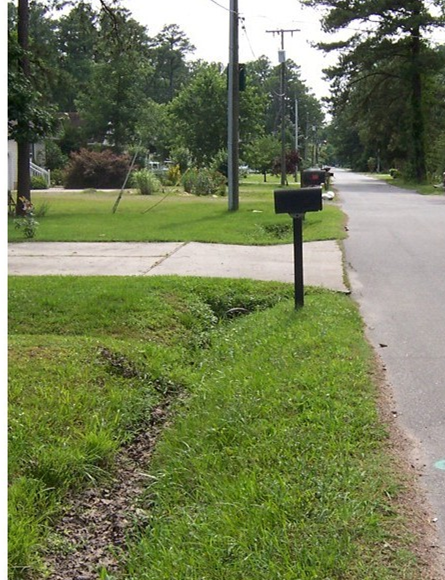One of the purposes of a roadway drainage ditch is to prevent unsafe accumulations of rainwater on the roadway surface. An open ditch allows water to move fully away from a road surface. In contrast, a piped storm sewer system uses the edge of the roadway surface if there is a curb, or a shallow swale over the former ditch to convey the water until it reaches a catch basin or other point of interception. An open ditch also continuously intercepts rainwater flowing toward the roadway from adjacent land. For these reasons, a roadway drainage ditch is less likely to allow accumulation of water on or near a roadway surface than a storm sewer system.
Roadway Base Drainage
Another purpose of a roadway drainage ditch is to drain water from under the roadway. The base is the foundation for supporting the load of traffic on the asphalt roadway. If water becomes trapped in the base, it weakens the structure of the roadway, leading to premature failure of the roadway. In addition, during cold weather, freezing and thawing of water trapped in the base under the pavement causes rapid deterioration of the pavement. An open ditch of sufficient depth provides continuous drainage of the base.
Flooding Reduced
An open ditch has more capability than a piped system to reduce flooding resulting from heavy rainfall. During an extreme rainfall event, flow in a roadway drainage ditch is usually limited by driveway culverts or water elevations at discharge points, such as intercepting streams. When that happens, each roadway ditch becomes a small detention basin, storing excess water until discharge capacity becomes available. A piped system does not have the capability to store excess water. A piped system also accelerates water flow, making downstream flooding conditions worse.
Water Quality Issues Improved
An open ditch helps to maintain healthy water quality in receiving streams:
- Vegetation in a roadway drainage ditch provides valuable filtering of water. Roadways gradually accumulate rubber tire wear, lubricants, metal particles, rust fragments, and other substances from the wear and weathering of motor vehicles. These substances, as well as roadway materials loosened by wear and weathering, are washed from roadways by rainwater. Ditch vegetation helps to trap these substances, and reduce flow rates, promoting settlement of solid particles and preventing them from entering the natural waterways. The mowing of roadside ditches should be kept to a minimum in order to maximize filtering.
- Ditches reduce flow rates and increase storage of excess rainwater which helps reduce downstream erosion and the impact on stream habitat caused by high concentrations of suspended solids.
- The detection of illicit discharges is easier in open ditches than in closed piped systems. EPA rules require that non-rainwater discharges be eliminated from urban drainage systems. Such discharges include failing septic system discharges and disposal of solvents, motor vehicle fluids, and cleaning products.
Infrastructure Costs Reduced
Piped drainage systems, including storm sewers, catch basins, manholes, headwalls and under-drain piping are much more costly to construct than roadside ditches. If a piped drainage system is constructed without adding an adequate under-drain system, additional costs are incurred for roadway repair and reconstruction due to roadway deterioration caused by inadequate base drainage.
It is at the Road Superintendent’s discretion to repair, replace or remove any failing drainage structure within the Township’s right-of-way. It is not the obligation of the Township to maintain or improve the storm drainage facilities across any individual’s property.
Coventry Township will not replace failing pipes but will open the ditch wherever possible to improve drainage throughout the Township. Open ditches are preferred to closed ditches wherever applicable.
Driveway Culverts
Per the Ohio Revised Code (5543.16) owners of land shall construct and keep in repair all approaches or driveways from the public roads. Driveway culverts are considered part of the approaches and driveways and are the responsibility of the property owner. Property owners are responsible for the cost of the driveway approach and pipe as well as for the maintenance and repair. Per Ohio Revised Code (5571.16) property owners are required to obtain a permit as approved by the Township Road Superintendent. Please see the Township website at www.coventrytownship.com for the permit application form – also available at the Township Administration Office.
Ditch Maintenance
It is important that all Township Ditches be kept clear of obstructions that would impede the flow of water:
- Please do not dump grass clippings, leaves or other debris into/or adjacent to storm water ditches, channels or swales.
- At times, natural obstructions such as trees or tree limbs, beaver dams, brush or bushes may fall into ditches. These obstructions, if left unattended, may cause a ditch to become clogged and overflow.
- Please report any dumping or obstructions in Township ditches to the Coventry Road Department at 330-644-0785, ext. 680.
*This policy and supporting information has been adopted based on the Summit County Engineer’s Ditch Enclosure Policy and Driveway Pipe Policy and Procedure.

